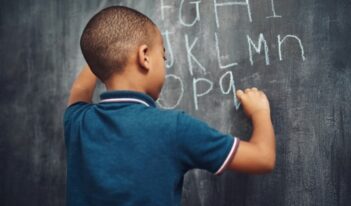
Scholars reflect on school discipline’s inequitable impact.
The U.S. Department of Education reported that out-of-school suspensions cost students across the country 11,205,797 days—or approximately 61,750 school years—of instruction in the 2017-2018 school year. These numbers represent a striking learning deficit, and the report reveals pronounced disparities in school opportunity and experience along racial and disability lines.
In recent decades, schools have turned increasingly to exclusionary discipline policies—namely, classroom removal via suspension or expulsion—to meet their obligation of maintaining safe learning environments. The passage of the Gun Free Schools Act of 1993 further entrenched such methods of behavioral correction by tying federal funding to a mandatory expulsion requirement for students who brought weapons to school. Many states subsequently passed “willful disobedience” statutes that punish students’ non-violent behaviors with suspension.
Despite legislative intent to make schools safer, exclusionary discipline can damage a child’s learning experience and diminish their long-term potential for success in school. Indeed, students subject to exclusionary discipline are more likely to be held back or even drop out of school. Exclusionary discipline also increases the chances of students becoming involved with the criminal justice system and experiencing economic instability in adulthood.
The effects of exclusionary discipline are not equitably spread across student populations. Data indicates a growing trend of removing young learners from the classroom at a critical moment of development: preschoolers are expelled at three times the rate of K-12 students. In addition, research demonstrates that Black boys and students with disabilities are disproportionately subjected to exclusionary practices as compared to their peers.
Still, exclusionary discipline remains largely unregulated at the federal level, despite attempts by the courts and federal entities to protect students from undue exclusion. For example, in the seminal case Goss v. Lopez, the Supreme Court mandated procedural due process for students facing expulsion or suspensions longer than 10 days, reasoning that sustained instances of exclusion can seriously harm a student’s standing and future opportunity. Furthermore, the Individuals with Disabilities Education Act (IDEA) seeks to protect at-risk student groups by imposing a 10-day limit on exclusion and requiring that schools place children in an “appropriate interim alternative educational setting” when removed from the classroom. Nevertheless, the use of exclusionary discipline has remained persistent, with its discriminatory effects impacting students even in the age of virtual learning.
In this week’s Saturday Seminar, we collect scholarship discussing the state of exclusionary discipline and advocating for transformational change.
- A recent joint report by Arizona State University’s Children’s Equity Project and the Bipartisan Policy Center finds that Black children—specifically Black boys—and children with disabilities are subject to exclusionary discipline at markedly higher rates than their peers. Despite comprising only 19% of public preschool and 15% of K-12 enrollments, the data indicates, Black boys represent 45% and 39% of suspensions, respectively. In addition, children with disabilities are twice as likely to experience exclusion from the classroom, and Black children with disabilities are the most likely to be excluded. Contributors to the report contend that reversing racial discrimination in exclusionary discipline will require a collaborative effort by Congress, federal agencies, states, and school districts. For example, they posit, federal agencies could require states to report their use of exclusionary discipline, or they could tie federal funds to reducing racial and ability disparities in expulsion and suspension.
- Antidiscrimination law could more effectively address racial disparities in expulsion and suspension for students with disabilities by rethinking the metrics through which states and the federal government assess discrimination in school discipline argues Erik James Girvan of the University of Oregon School of Law in a forthcoming article in the University of Memphis Law Review. To identify significant disproportionality in disciplinary impact, Girvin notes, states routinely rely on direct measures such as overall discipline rates per racial group. This, he argues, can ignore myriad factors that contribute to students violating their schools’ behavioral expectations. Drawing inspiration from IDEA’s problem-identification framework, Girvin advocates using a combination of different measures—including raw differential representations, which examine how many students in a target group experience at least one instance of exclusionary discipline they would not have otherwise experienced if they were part of the comparison group—to promote data transparency and accountability in this area.
- In a recent report published by the University of California Civil Rights Project, Daniel J. Losen and Paul Martinez explore the disparate impact of exclusionary discipline in the education system. Losen and Martinez claim that demographic school suspension data reveals alarming racial disparities, as Black students lose days of school instruction due to exclusionary discipline at disproportionately higher rates than their peers. These disparities are even more prominent when the data is categorized by gender, they argue, as Black male students are the most likely group to be suspended, followed by Black female students. Losen and Martinez find that Latino, Native American, and Black students suffer inequitable access to educational opportunities as a result of exclusionary discipline policies. To address this disparity, Losen and Martinez recommend that educators implement non-punitive disciplinary strategies that encourage emotional learning and conduct correction. Losen and Martinez urge policymakers to support non-punitive alternatives, teacher training programs, and other informative efforts to recognize and diminish the influence of racism within school discipline.
- In an article published in the University of South Carolina Journal of Law and Education, Sarah A. Husk discusses the negative impacts of exclusionary discipline on students with disabilities and suggests reforms to IDEA. Husk explains that a primary goal of IDEA is to protect students against unfair, punitive discipline for behaviors resulting from their disability. She argues that the “manifestation determination review” (MDR) process—an IDEA procedural protection used by schools to determine if disciplinary action is appropriate—is flawed and unworkable. The MDR process protects against exclusionary discipline only if the misconduct is determined to be a “manifestation” of the student’s disability, Husk claims. She finds the MDR inquiry process to be ableist and illogical, as it invites subjective discretion and implies that a student’s disability is conditional. Husk insists that the “best interests of the child” standard rooted in family law provides a better framework for the MDR process. She argues that this standard would allow for a more individualized, understanding approach that would help students educationally and socially, better meeting IDEA’s goal of educational inclusion.
- In an article published in the UC Davis Law Review, Thalia González of Georgetown Law School and several coauthors analyze current school-based restorative justice schemes codified in state education laws. Restorative justice schemes, González and her coauthors explain, aim to transform school disciplinary procedures into “non-punitive philosophies and practices.” González and her team find that state laws contain inconsistent definitions of restorative justice within them. González and her coauthors argue that such definitional ambiguity can lead to inconsistent implementation of restorative practices at the local level and raises ethical issues. González and her team recommend that policymakers explore these areas of concern and evaluate whether restorative justice laws are promoting equitable discipline and effectively transforming educational environments.
- In an article published in the Notre Dame Journal of Law, Ethics & Public Policy, Miranda Johnson and James Naughton of Loyola University Chicago School of Law discuss the limited legal protections available for students facing transfers to alternative schools. Johnson and Naughton explain that state laws significantly vary in how much due process they afford students facing disciplinary transfers. New York, they describe, provides opportunities for formal hearings before students are transferred, but Wisconsin’s school code does not include an opportunity to appeal a principal’s decision to transfer a student. Johnson and Naughton argue that such transfers can be harmful because alternative schools often have fewer extracurriculars available and offer students a lower chance of graduation. They recommend state statutory reforms to limit transfers, such as implementing mandatory hearings before a student may be transferred and limiting the amount of time a student may stay in an alternative school.



